The Fathead Diver
By Skip Morris
In The Sunfishes, A Fly Fishing Journey of
Discovery, Jack Ellis describes his Fathead
Diver as "a very small Dahlberg Diver," and for the
most part it is. There are really only two significant
differences: (1) the Fathead Diver has a simpler tail
than most versions of the Dahlberg Diver, and (2) the
Fathead has a snag guard of unique size and unusual
design.
A snag guard in a pan-fish fly - when I first saw it
I was skeptical. In fact, it struck me as rediculous.
Experience told me that most pan fish have small mouths -
so small that they have trouble enough getting a plump
fly into that mouth without adding to that a bulky
snag guard - and that their taking of a fly is too light
to get past that snag guard to a hook's point anyway.
On the weight of experience, I ignored the pan-fish snag
guard for a full year.
Then, finally, I tried it. And it worked.
So I'd relied on the weight of experience, and that
experience had proved to be underweight. Another lesson
in humility, one among thousands. Humility is one topic
I can discuss intelligently.
...In The Sunfishes, Jack describes three
patterns for his Fathead Diver: the standard version
described in the pattern below; a shad version with a
marabou and Flashabou tail and a cream or pale-yellow
body and collar; and a frog version with a grizzly-hackle
tail, a chartreuse collar, and a cream or pale-yellow body.
But in his article in American Angler includes a
photograph showing Fatheads with hair of green, purple,
white, yellow and red. This suggests that colors for this
fly are open, as, in fact, they are for nearly all bass
and pan-fish flies....But as with all the flies in this
book, I'll show you may personal approach to tying this
one, not because my way is the best, but because I
understand my way best.
The Fathead Diver does its work very well. Of course it
is as Jack freely admits, nothing new, just a couple of
twists on an already established fly. Still, a tiny
Dahlberg Diver...a good idea.
Materials List: Fathead Diver
Hook: Regular to heavy wire, short shank to 1X long
(a tiny bass-bug or stout dry-fly hook), sizes 10 and 8.
(The hook shown is a Mustad 3366, which Jack uses for this fly.)
Thread: Red 3/0 for the snag guard and tail;
white or gray size-A rod thread for the collar and body hair
(Jack prefers 6/0 and 3/0)
Snag Guard: Mason or Maxima monofilament of 0.012 diameter
(A snag gurad is optional.)
Tail: Squirrel tail under red marabou under brown marabou.
Skirt: The stacked tips of the first bunch of collar-hair.
Collar: Natural deer hair.
Body: Natural deer hair.
Tying the Fathead Diver
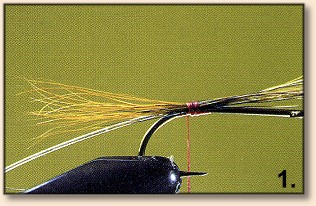
1. Start the 3/0 thread on the shank, directly over the hook's
point; then bind on the end of the snag-guard monofilament, again,
directly over the hook's point. Wrap tight thread-turns to the
bend - but do not wrap down the bend as you normally would for
a snag guard (A snag guard here is, as usual, optional.) Bind
in a small bunch of squirrel tail over the mono. Trim the hair's
butts closely. The squirrel can be stacked, if you wish, and
should project 1 to 1 1/2 shank lengths from the bend.
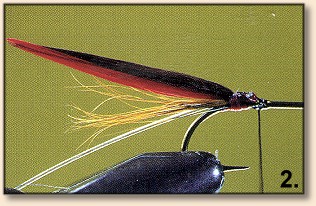
2. Bind a bunch of red marabou over the squirrel; then bind a bunch of
brown marabou over that. Trim the marabou's butts closely. Use only
small amounts of marabou. The marabou should extend noticeably beyond
the tips of the squirrel. Here, I moistened the marabou before tying
it in - this really increases control.
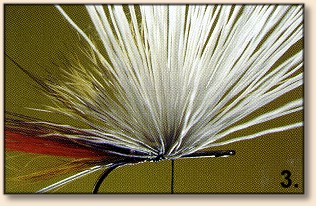
3. Whip finish the thread slightly ahead of the tail, trim
the thread, and start some size-A rod-wrapping thread over the
whip finish. Cut, comb, and stack a modest-sized bunch
of deer hair. Hold the bunch atop the shank and take 2 light
thread-turns around it. Hold the hair firmly in place and then
pull the thread tight. The tips of the hair should end slightly
before the tips of the squirrel.
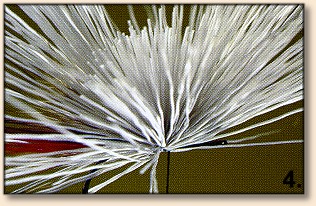
4. Secure another modest-size bunch of hair in front
of the last; again, it should stay mostly atop the hook.
This bunch needn't be stacked. Compress this second
bunch back into the first.
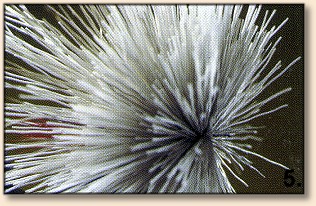
5. Flare and compress hair to just back from the
hook's eye (or right up to the eye, if you skipped
the snag guard). Whip finish the thread (or add 3 half hitches)
and cut its end.
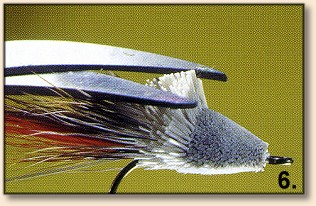
6. Shape the body exactly as you would for a Dahlberg
Diver (See Dahlberg
Diver.) Trim the collar as you would for a Dahlberg.
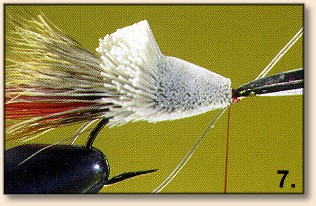
7. Start the 3/0 thread again at the hook's eye. Bring the
monofilament around the hook's bend and then up through its
eye, but don't fold it back - you can't complete this snag
guard in the normal fashion because if you do, there won't
be enough room remaining in the eye to accept a leader-tippet.
Adjust the mono snag guard to slightly undersize; then bind it
to the shank's underside with a few light thread-turns. Trim
its end right at the hook's eye. The snag-guard loop should
look oversize for the hook; use the photographs as a guide.
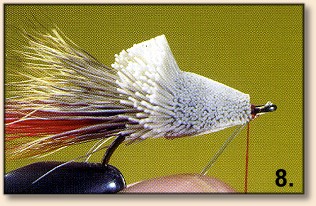
8. Slowly and carefully pull the mono back until its
end is under the shank, right at the rear of the hook's
eye. Add some right thread-turns, whip finish the thread,
trim its end, and add head cement to the whip finish. Jack
coats the colar with head cement. I don't. Your
choice. ~ SM
|



